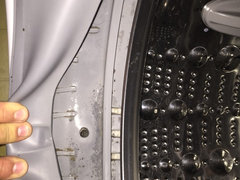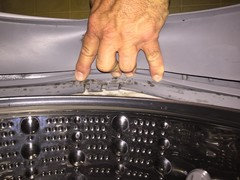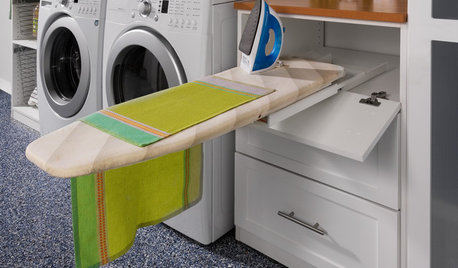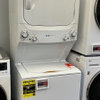Kenmore Elite Front Load Washer Smell
We have a two year old Kenmore Elite Front Load Washer and Dryer HE3t. Lately when we run the washer there is a terrible odor, like stagnant water, coming from the washer. It does not affect the clothes, but the entire laundry room smells everytime we wash clothes. Is there anything we can do to get rid of the odor??
Comments (113)
itguy08
12 years agolast modified: 9 years agoI'm going to prefix this by saying this may come off as a bit prick-ish and that is not my intent. In the written communication it may come out that way and that is not my intent.
What I mean by armchair quarterbacking is that people think they have all the answers and can do things better than those that design these machines. It seems to be getting worse lately on the Internet. Seems like someone has an issue, pulls it apart and thinks they can do better. Then everyone jumps on the bandwagon and it becomes this huge issue. This is not limited to appliances. I've seen it with cars, computers, cell phones, etc.
I seriously doubt there's a conspiracy to design a crummy machine. Where's the logic in it? It's been said that for every 1 customer you upset they will tell at least 7-10 of their friends. Who wants that? Not a company who wants to sell appliances and have repeat sales.
That being said, I think a lot of people got a FL machine and followed their old habits. That's the wrong thing to do. I wonder how many people used their old detergents, left the door closed, and wondered why it corroded away?
The manufacturers were partly to blame in the beginning. I remember in our 2005 LG 2077WM manual it said HE detergent was recommended. In our 2011 Kenmore there are numerous warnings that it is REQUIRED. I think HE detergents have more corrosion inhibitors in them than non HE detergents and those are necessary to protect the aluminum.
I can tell you that a washer is not the only thing that has dissimilar metals in contact with each other. Your car engine is filled with aluminum, cast iron, copper, bronze, and a few other metals all touching or in close proximity to each other. One of the components of coolant is silicates or other corrosion inhibitors. They help keep all these dissimilar metals from killing each others. Perhaps that's what was/is missing in old detergents?
If you look at the design of many of the newer washers, the hub of the spider is rarely in contact with the water (ours hardly ever fills it up that high), so I'm thinking corrosion may be there but the weight of the drum and contents helps it crack.
For us, we had our LG from January 3, 2005 to about April 20th 2011. Only reason we got rid of it was the 3.5 ft of sewer water that flooded it. We used HE detergents (Sears, Costco, Gain, etc), bleach (if the laundry room doesn't smell like chlorine when I do the whites it's not enough :), Oxyclean, etc. Never a hint of trouble with the bearings or spider. We left the door open after we were done for the day so the leftover water would evaporate. No smells, no nothing just clean clothes.
I just can't see how residual water that's allowed to evaporate could cause this issues alone. After all, the rinses should be removing the traces of detergent and leaving with regular old water which has a much less corrosive factor than the detergent/bleach mix.
In short I'm not sure what is causing these failures or if there is a rash of failures as the Internet would like us all to believe. But with the millions and millions of these machines in use all around the world I can't believe that it's a design flaw. Could be user error combined with some defective parts.
Maybe we've been lucky? Who knows? But I doubt it's a conspiracy to make us all buy new machines.
biguggy
12 years agolast modified: 9 years agoTo itguy08
Thank you very much for your response, I do appreciate your comments, and agree with some of them.I do not think that I 'have all the answers' in fact I know I do not. As an example when I first dismantled our Frigidaire built machine I thought that the corrosion of the spider was due to galvanic action. I am very familiar with the corrosion of aluminium when it is electrical contact with mild or high tensile steel in the presence of seawater and the products of corrosion on our spider looked just like what I was used to seeing, and I jumped on that bandwagon. I was in error. The products of corrosion are the same, just produced in a different manner. The fact that the connections at the ends of the spider arms were not corroded however nagged me so I did some research and found my answers. The best, and in my view most authoriative, I have referenced above and now repeat below: -
http://www.unene.ca/un1001/UN1001_Galvanic%20Corrosion.ppt
I strongly urge you to read it.
Now that left me with a problem, should the corrosion not be due to galvanic action what was/is it due to? Numerous internet searches along the line of 'corrosion of aluminium' soon gave me my answer, again the most authoritative I found is: -
http://www.sintef.no/static/mt/norlight/seminars/norlight2003/Postere/Gaute%20Svenningsen.pdf
Again I urge you to read it.
Whilst there may not have been a conspiracy to build a 'crappy machine' originally, Electrolux, the sole owners of Frigidaire, are in no hurry to take remedial action. The part number for the tub and spider assembly for our 2001 purchased machine is still the same as that for a machine purchased in May of last year. Reviewing the complaints on the web the problem with these Electrolux/Frigidaire spiders goes back to before 2001. They seem content with the situation; they either sell more machines or more of their overpriced spare parts, which, in some cases, are only available as assemblies. Additionally we purchased a second machine, similar to the first, in 2006, the instructions regarding use for this second machine are virtually identical to those for the first! Again Electrolux appear to be in no hurry to rectify the situation and, I believe, a successful argument could be put forward that at that time, 2006, they should have been fully aware of the problem. The number of spares that they must have been producing should, in my view, have given some clue. When I purchased new drum and spider for ours in 2009 the parts dealer I purchased it from told me they had 26 'in stock'. That should tell you something and it is not that parts dealers inventory control is lacking!
Now, your paragraph: -
"That being said, I think a lot of people got a FL machine and followed their old habits. That's the wrong thing to do. I wonder how many people used their old detergents, left the door closed, and wondered why it corroded away?"
I largely agree. In fact it is my understanding that when detergents first became generally available shortly after the Second World War unnecessary additives were put in just to give 'suds' or lather which did nothing for the cleaning power but the 'marketplace' wanted to see 'suds' as it had with the old soap. Heck back when I was a lad, and a fair bit after, the standard test for the hardness of boiler water was the 'Wanklyn Standard Soap Test' where the quantity of a 'standard' soap solution required to produce a lather in a specified size of sample, that would endure for a specified time, was a measure of the hardness salts in said boiler water. When we purchased our first FL HE detergents were not readily available so we used regular detergent and hence got 'suds' which I believe may well have contributed to the demise of the first spider. The FL manufacturing industry and the detergent manufacturers� are also, in my view, partially to blame for not explaining that the new HE detergents do not produce 'suds' I now know my wife and I also overdosed our first machine in its earlier days but how were we to know?
As for leaving the door open to allow the machine to dry out. To my mind this has some validity for the boot at the front of the machine and perhaps the dispenser tray. However in the case of the recesses in the spider of these Frigidaire built machines the open faces of the recesses of the spider are only about 1-2mm from the face of the case of the seal. That will, in my opinion, only allow limited, slow evaporation to take place. Added to this should any of the sediment/impurities left in the recesses contain sodium carbonate, this chemical, being hygroscopic, will remain damp and thus corrosive to aluminium and supply the necessary moisture to allow other sediment to fester and smell. Where will this water come from, the atmosphere and the reservoir that is the 'penny trap' as there will always be a pint or two down there at the bottom of the outer drum.
I am well aware of installations have various metals in contact with each other and your example of the internal combustion engine is well taken. However the designers of these have a great deal of control over what liquids are in contact with the various metals. The designers of washing machines do not have this luxury, who knows what sort of 'soup' finally is left? Additionally it will vary from load to load."If you look at the design of many of the newer washers, the hub of the spider is rarely in contact with the water (ours hardly ever fills it up that high), so I'm thinking corrosion may be there but the weight of the drum and contents helps it crack."
I believe if you check closely you will find that your washer never actually fills above the bottom of the door and never to the hub of the spider. Whilst I agree that the hub is never totally immersed in water it is none the less wetted in every phase of the washing and rinsing phases. During the spin phase the linear speed at the edge of the recesses is, I believe, insufficient to throw out all the water and contaminants from this area. I do agree that once any imperfection manifests itself in a corrosive environment the possibility of catastrophic fracture increases dramatically. When I retired, six years ago, although the subject of stress corrosion was well known, the actual mechanics of the processes were not so well understood. Therefore I do agree that the weight of the drum, laundry and spider all will contribute to a cantilever effect at, or close to, the hub, which may well accelerate the failure process. What developments have taken place with respect stress corrosion since I retired I do not know.
"I just can't see how residual water that's allowed to evaporate could cause this issues alone. After all, the rinses should be removing the traces of detergent and leaving with regular old water which has a much less corrosive factor than the detergent/bleach mix."The point is that the rinses are not removing all the contaminants, particularly from the recesses of the spider. To see the visible contaminants left in the water, and therefore the laundry, catch some of the last rinse water as it is pumped out and see how unclear it is, and that is only what you can see never mind what you cannot see. Should you wish to see that leave a little of the last rinse water in a saucer, bottle cap or something similar and let the water evaporate and then compare that with a sample of 'tap' water that has also been allowed to evaporate in a similar manner. Hopefully you will see what I am getting at. Just as a point of interest our Frigidaire does not even spin after the wash phase.
Thank you again for your comments and I would appreciate any comments that you may have on my above remarks.
itguy08
12 years agolast modified: 9 years agoI did take a look at the 2 links you sent and wow. The first one made my head spin like when I took college chemistry all those years ago. :)
I'm still having a hard time wrapping my head around galvanic corrosion. From what I got from the Powerpoint this type of corrosion only happens when there is water present contacting the 2 dissimilar metals. Remove the water and you have a lot less corrosion. I would think that letting the water evaporate by leaving the door open would eliminate that. If the spiders can't take that I would suspect poor engineering. Or if the breaks were at the drum end. Many of the breaks I've seen seem to be near the shaft where it goes through the tub. I would think that gets less water and dries off quite quickly.
The second link was quite interesting - the environment of the machines definitely could be acidic or basic (is that a word) so it may strip the protective oxidation on the spider. But I would think that it should hold up better than that or have some type of coating to prevent this.
I'm really not sure what the cause is. I know we used a lot of bleach in our previous LG and it lasted 6 years. The spider and tub components were not the cause of us getting rid of it. Sewer water flooding it was.
I'm wondering if it is/was a bad casting or metal that has been the cause of these failures. It seems like the Frigidare units have been the ones with the most issues. I wonder if they did in fact have a design flaw or bad metal. We'll probably never know.
I wouldn't go by the part numbers being the same as to them not making changes along the way. I've been around cars and computers enough to know they often revise a part along the way. Many times it keeps the same part # (for simplification of the parts systems and techs) but new parts often are different than the older parts. So there may be parts that have the same # but are significantly different.
It's a very interesting discussion that's for sure.
Cavimum
12 years agolast modified: 9 years agoIf this newbie may ask a question . . . why are spiders made of aluminum? Would a different metal perform better, like stainless steel?
itguy08
12 years agolast modified: 9 years agoMy guess is weight and ease of manufacturing. The spiders I've seen seem to be made of cast aluminum. Casting is an easy process and usually results in tough parts (think cast iron). Aluminum is lighweight and durable and easy to cast (airplanes are made out of aluminum). When you're schlepping machines from Korea, China, Mexico, or even within the USA light weight = savings.
biguggy
12 years agolast modified: 9 years agoTo itguy08,
Thank you for your response. I was much of your mind when I first read the paper on galvanic corrosion, took me back a good many years! For the purpose of the discussion in this thread I think the important points are made on the following pages: -
Pages 20 and 21 - passivation can alter the behaviour of some metals.
Page 35 - oxide puts an additional electrical resistance in the electrochemical circuit.
Page 36 - oxide film effects. The oxide film on stainless steel is electrically insulating and impedes the charge flow between galvanic couples. Additionally the aluminium oxide film on the aluminium makes the Aluminium nobler.
Pages 39-43 - Discussion on which to coat, and why, anode or cathode?I largely agree with you, for galvanic corrosion to take place an electrolyte has to be present and that electrolyte is not always water or 'liquid'. Take the example of the Daniel Cell in the paper it is a paste. One thing I did learn from that paper is that the metals do not actually have to be in 'electrical' contact with each other for galvanic corrosion to take place (page 52 of the paper). I always thought they did.
For purposes of this discussion I further agree with you, remove the water and the corrosion ceases. Unfortunately in the case of the front load washers this is easier said than done. Whilst leaving the door open will allow some drying off to take place there are areas inside the washer where the surfaces of the aluminium alloy are close, or very close to other surfaces. These are: -
The ends of the spider arms where the setscrews pass through the rim of the stainless steel tub into the spider.
The holes in the end of the spider arms that the setscrews are fitted into.
The recesses in the hub of the spider, the open faces of which are only 1-2mm from the face of the cage of the seal.
Any water and contaminants left in these areas will, in my opinion, only 'dry out' very slowly. Add to this that should one of the contaminants left behind be sodium carbonate, in addition to being corrosive to aluminium, it is hygroscopic and it has an ample source of water to draw upon from the 'pool' left in the 'drain' at the bottom of the drum.Unfortunately this site does not allow for photographs to be included with the posts or I could show you the build up of corrosion products on the ends of the arms and in the screw holes on the spider removed from my Frigidaire built machine.
'Basic' or 'alkaline', either describe a liquid or paste with a pH level above 7.0. Below 7.0 it is 'acidic'. One further point to remember here is that the pH scale is logarithmic, to the base 10. This means that a substance with a pH value of 9.0 has ten times more hydroxide ions than a substance with a pH value of 8.0. Additionally totally acidic is 0 not 1 as some people would have us believe.
I totally agree with your evaluation that the spider should be coated to prevent corrosion, or use a material that can withstand the environment it has to work in.
One thing I have noticed is that many of the complaints about spider corrosion note the fact that the machine in question only had 'light' or 'little' use; ideal, in my view, conditions for corrosion to take place. A machine used more frequently would not be as likely to 'dry out' sufficiently or as frequently to the stage where corrosion commences. Hence the reason for laundrymat machines not to suffer failures as frequently as machines used domestically.
I do not believe that the Frigidaire built machines suffered from 'bad' metal, other than the fact it is, in my view, a very poor choice of material. The geometric design also in my view, is lacking in forethought as, again in my view, it is designed to enable the recesses in the hub to hold water, which, in time, will turn foul even if the material was resistant to the corrosive environment.
I am aware that in many industries part numbers remain the same even though changes to materials and geometric designs do take place. However in the case of the Frigidaire spiders, as I have said the part numbers have stayed the same. I could not tell any difference between the spider I removed from the Frigidaire built machine purchased in 2001 and the replacement spider I purchased in 2009. I know the older spider had corrosion damage but the basic geometric design did not appear to have been changed. It is possible that minor changes to the material physical specifications may have been made which are not apparent to visual inspection but the fact remains that aluminium and its alloys are corroded when immersed in an aqueous solution with a pH value above about 8.0.
Thank you again for your contributions, it is, as you say, an interesting discussion.
I welcome any further comments you may have.
dadoes
12 years agolast modified: 9 years agoUnfortunately this site does not allow for photographs to be included with the posts or I could show you the build up of corrosion products on the ends of the arms and in the screw holes on the spider removed from my Frigidaire built machine.Pictures can be included in posts, but they have to be hosted elsewhere online, such as at Photobucket or other free photo-sharing service, and linked into the post with html code.
Cavimum
12 years agolast modified: 9 years ago"One thing I have noticed is that many of the complaints about spider corrosion note the fact that the machine in question only had 'light' or 'little' use; ideal, in my view, conditions for corrosion to take place. A machine used more frequently would not be as likely to 'dry out' sufficiently or as frequently to the stage where corrosion commences. Hence the reason for laundrymat machines not to suffer failures as frequently as machines used domestically."
@bigguggy - This may answer my next 'newbie-to-world-of-FL washers' question(s) I had, but I'll pose it anyway: Do Europe and UK have this spider corrosion/failure problem we have here in the U.S., and perhaps all of North America?
From what I have learned from all my reading, the FLs in Europe & UK are smaller capacity, so probably they are used more frequently than our ginormous ones. Based on the information you've given, smaller capacity FLs might have less failure because they rarely dry out completely?
Thanks. The whole thing has fascinated me.
biguggy
12 years agolast modified: 9 years agoTo Cavimum.
Thank you for your comments. Whilst I cannot comment for the rest of Europe being a Limey/Brit. I do have a bit of knowledge about the UK.Whilst I had not thought about domestic machines in Europe being used more often because they are smaller it is, I believe a valid consideration. What I think is much more likely is that the Europeans, as a whole, seem to use a lot less bleach, sodium hypochlorite, than is used in households in North America. I was over to the UK in October 2009 and my parentsâ, just under 4 year-old; Hotpoint Aqualis had just had its bearings renewed. That machine had no provision for the use of bleach and its use was not mentioned on the âInformation Sheetâ that came with the washer in lieu of the owners manual, another cost cutting move I suppose.
I am given to understand that the lack of provision for the use of bleach, as in my parentsâ case, is âthe normâ in Europe. Up until relatively recently, even for machines sold in North America Bosch used to prohibit its use on pain of nullifying the warranty. I wrote to Bosch and asked them what had changed, they informed me the older âhosesâ would not tolerate bleach but that the ones fitted to the newer models would. They (Bosch) further informed me that their spiders were manufactured from aluminium alloy but they omitted to respond to my query about recesses in the spider.To see what one drop of bleach, straight from the bottle, did to the spider I removed from our Frigidaire built machine please visit âReply # 21â at the following thread: -
http://www.automaticwasher.org/cgi-bin/TD/TD-VIEWTHREAD.cgi?29564Once again thank you for your comments and I look forward to hearing from you again.
aspazqueen
12 years agolast modified: 9 years agoI had this problem I used a product called TechnoFresh. I have tried smelly washer it is OK, then my machine started acting funny so I got a new set. I use TechnoFresh in between "Pure Clean" cycles. It is a great product and cheaper than Afresh.
biguggy
12 years agolast modified: 9 years agoTo aspazqueen
On reading your post, I had never heard of TechnoFresh before, I sent them an email asking where I could find a copy of the MSDS (Material Safety Data Sheet) for their product. Their response was to forward me copies of MSDS's for the ingredients. These are: -
Boric Acid
Citric Acid
Magnesium Sulfate
Potassium Sorbate
Sodium Benzoate
Sodium Borate
Sodium Percarbonate
Now what the percentages of these are I do not know, neither do I know how the acids will react with the alkalis when water is added, or what properties the resultant 'mix' will have.
The MSDS supplied for the citric acid notes that it is corrosive to aluminium, similarly for the sodium percarbonate. Sodium percarbonate is one of the main ingredients in 'Affesh' and the powdered 'Oxi' products. Now as sodium percarbonate reacts with water to form hydrogen peroxide, which is the cleaning agent and degrades relative quickly, and sodium carbonate (washing soda), which is hygroscopic and when damp/wet, very corrosive to aluminium once the required concentration is reached.
As far as I am aware the spiders fitted to front load washers in North America are manufactured from aluminium alloys.
Draw your own conclusions.ENORMS
12 years agolast modified: 9 years agoMy 8+ year old washer has been very reliable...it has had some parts replaced by myself...but that darn smell!! This past weekend I did the unthinkable! I literally tore down the entire washer to get to the tub & basket. And what do you think I found? A coating of brown bio-film on the back-side of the stainless steel basket and the same on the plastic tub. DISGUSTING!! (I may have the two pieces confused with each other). I used my 1600psi pressure washer on each item until thoroughly cleaned off (do the washing on your grass); also did the same with the rubber boot. There are instructions you can download to do this tear down...they are for the Whirlpool Duet..but that is the company that make the Kenmore HE series. Took about 6 hours for me...but well worth it and NO MORE SMELL!! Comments welcome
asolo
12 years agolast modified: 9 years agoFWIW,,,,I've had Duet 9400 for 6+ years. Because of reading complaints here I've regularly checked the machine. Inspect boot all around; get in there with a powerful flashlight and look at the drum carefully; and through the holes in the drum to inspect the outer drum.
Nothing. Ever. Machine looks like it came off the showroom floor yesterday.
Long-winded way of saying I don't know what your problem is. However, clearly it isn't the machine's nature in and of itself. Something else is happening there, IMHO.
Laurel Zito
12 years agolast modified: 9 years agoThis is why I would never get another front loader. Mine did leak and mildew got into the rubber door seal and it did smell and there was grimy stuff leaking down the front. The solution would be next time get a top loader. I just got one of those. Now this LG I got is also leaking, but at least I feel I am on the right track with rejecting front loaders.
mihi
12 years agolast modified: 9 years agoThe bad smell that comes from a washer will get into the cloths. Often you won't smell it in the cloths when you take them out of the washer or dryer, but when wearing the cloths and your body heats and moisturizes them you will then smell the slight odor.
This is caused by mold growing in the washer. If nothing else works, and it didn't for me and I tried everything in my washer, which was and is a Staber, I took it out of service. I then let it sit for a year and dry out, then ran Afresh through it and put it back into service. It hasn't smelled since. I only use powder detergents now, though occasionally I will use a liquid here or there for various reasons. I try to go easy on any of the liquid softeners and use the new Purex crystals for this primarily now, or vinegar.
Good luck with the mold problem, it's a major issue.
CharterOps
12 years agolast modified: 9 years agoI have always used the recommended amount of detergent and FS. After I'm done washing for the day; I do the following: (Top-to-bottom routine) I pull the dispenser tray all the way out; rinse it and put it back in but leave it open about 1 inch or so; then wipe the glass door dry; then move over to the gasket/assembly and wipe it all completely dry. Then DONE! It all takes me no more than 3 minutes max. I keep a dedicated towel for the washer hanging up on the rack next to the detergents. I have done this routine since I bought my first FL, now on my 2nd (Electrolux IQ Touch). I've never had any bad smells in my laundry or machine; oh yes, I forgot the mention the important part. I leave the door open any time the machine is not in use. The Electrolux have spring-doors so I use one of those stretch cord things (gaaah, I fail to think of it's name at the moment) to hold the door open about 45 degrees open angle. That might seem like a lot of work to some people but think about it: Textiles have changed, Washing machines have changed, Detergents have changed, How water is processed at the plant has changed (if you're on city water); therefore, upkeep maintenance has changed. Ok, I'm off my "soap-box" and back to my laundry. - Have a great day folks :-)
christinasaid
12 years agolast modified: 9 years agoThis washer is really horrible and has been nothing but a problem. It was so expensive and not worth the money. We also have a problem with constant mold in the belt area (front). I have used Affresh, wiped it out and left the door cracked-it does not work. We discovered that it's leaking this morning and is going to cost $214 for Sears to come out and fix it. Really frustrating!
HollisH
12 years agolast modified: 9 years agoThis looks like two problems, maybe. The moldy, mildew smell may be different from the sewer smell. Our washer stinks like a sewer (hydrogen sulfide, rotten eggs) and the stench is most powerful when we drain the water from the hose behind the little door on the lower left front of the washer. I think the smell is from sulfate reducing bacteria and it is temporarily cured by draining the foul junk and running a "Clean Washer" cycle with liquid bleach. The real question is why such a goofy design which collects stagnant water? Our solution is temporary, a pain in the neck and disgusting to perform monthly, but I haven't seen anything here which hits our problem. Our clothes don't stink, but the house does.
mihi
12 years agolast modified: 9 years agoHere is something else to consider. If your laundry room smells but there isn't any bad smell in your clothing even when they get warmed-up on your body in the summer, consider yourself lucky as you probably don't have mold in the machine. When I had mold in our machine our cloths would get a "turdy" smell when you got warmed-up and sweaty in them. It wasn't very strong, you had to really smell the cloths to find it, no one around you ever noticed, but it was there.
So if not the washer why is a house smelling? Its an issue with the drain plumbing. If something is stopping up the vent pipe it will often cause the water that is normally left in a trap to be sucked out. The trap hold water in order to block/stop the odor from coming back into your house. Make sure you vent is operational first before anything, it's an easy fix.pwdman
11 years agolast modified: 9 years agoAfter having our washer for a short time, we also noticed that it started smelling bad. One day I took the detergent tray out of the machine and there was a lot of mildew in this area. I cleaned it with bleach and the problem went away. On another note, I suggest cleaning the drain pump filter. I just had to replace my drain pump because a sock got through the system and blocked the pump which caused the motor to burn up. There will be quite a bit of water that comes out when you open the filter so be prepared.
Stephen Wilson
9 years agoSO I have a Kenmore Front loader Model # 41172211. So has anyone heard if there is a class action suit against Sears and Maytag on these washers. It has to be a complete design problem. I formerly owned a Kenmore Front Loader that I had purchased in the late 90's. I never had a mold problem at all I didn't have to take all the necessary steps to try to reduce the mold and mildew problem like cleaning the boot constantly and running Bleach in it all the time. I think this is just piss poor engineering on the part of Kenmore/Maytag. At this point I could care less that this machine is supposed to be water efficient. I would just prefer that my clothes would get cleaner and that the damn machine wouldn't stink. Sears needs to put out a recall on all of these machines.
sparky823
8 years agoYou are several years behind on Sears and recalls. What brand detergent you use now in this LG/KM?
Stephen Wilson
8 years agoI use the HE liquid detergent. Brand depends on what is on sale but I was make sure that it is a detergent for HE machines. So what recalls are you talking about? I never got a notice of a recall from Sears. I finally went back down there to find out if there was any news on the class action lawsuit against them. Do you know a a recall specific to the LG/KM Front load machines?
Here is a picture of the bottom of the seal/gasket. As you can see the area around the opening of the Drain hole is actually higher than the surrounding area so it never dries out and of course gets moldy.

Needless to say I spend extra buying those cleaning tablets "Affresh" and running the washer clean cycle 2 to 4 times a weeksparky823
8 years agoThe "recalls"/lawsuits have been going on for years. Its been all the companies, Whirlpool, Maytag, Lg as I said all of them. When Sears had them(lawsuit) on the Kenmore machines I think most of those machines then were made by Whirlpool for Sears. Been so long I have forgotten a lot of it but you can google it and find all of that.
Stop using the liquid detergent, go to a good powder and see if that doesn't help. Most techs will tell you not to use liquids because they slime over everything then start stinking and you have a mess. The affresh is not going to clean the slime/gunk off the gasket around the door. Get some bleach and mix with some water(say 3/4 -1 cup bleach to 2 cups water) and a rag and scrub all around the door and gasket. Then add a cupful of Cascade Complete is best, powder dishwasher detergent, set for a hot wash and run through a cycle, not the tub clean, just normal. When you finish washing everytime, dont forget to leave the door cracked so air can get in there and dry it out. Be sure you dont use cold water all the time cause that is just feeding the problem, and be stingy with the detergent. If you use powder dont use more than 1/4 cup, even less liquid. LG says not to use over 2 tablespoons per load.
I just went back and reread your post---sorry I have told you a lot of things you already know. This LG machine may seal tighter than the other "Kenmore" you had.Just difference in manufacturers. I still say(and have heard others say) as soon as they switched to HE powder they saw a difference. I have a Maytag that is 15-16 years old and I have none of this. I rarely ever wipe my gasket off and when I do there is nothing there, but for the most part I only use powder.
I hope you get some powder and try it and just see if it helps.
I bet your previous washer was made by Whirlpool.
georgect
8 years agoHow long did it take for that gunk to build up?
I have a new Electrolux (70 series) and have passed my 50 load mark and my boot is clean as a whistle.
I'm using liquid detergent. So far Wisk HE and now Persil ProClean HE.
Having soft water, I only need like 2 Tablespoons of detergent. I've started using borax and a little baking soda to help keep things clean.
I do hot & warm water washes and "Sanitize" once in a while (which I feel keeps clothes AND washer super clean).
My Electrolux will auto suggest a "Clean Washer" every 50 cycles (which I've done with just 1 cup of bleach, recommended).
I am fanatical keeping this machine clean. Door & detergent drawer open until next use.
So how long does it take for that slime to build or is that from not doing hot or Sanitize washes and not keeping the open to air dry the drum after use?
Stephen Wilson
8 years agosparky823 Thanks for the response but I've done all of those things, except for switching to powder. I even had the Sears sales guy tell me to try running the clean cycle with a cup of white vinegar. Since that always works to get rid of the scale in my dishwasher I thought it seemed like a reasonable idea. After I ran it the washer smelled like vinegar and it took three extra clean cycles to get rid of the smell of the vinegar. That tells me that it has a problem. If Sears doesn't come through I will NEVER but another Kenmore product and that's sad because my family has used nothing but Kenmore since I was a kid and my wife and I have nothing in out house except Kenmore appliances.
As you can see that this part of the washer that I am able to actively clean and wipe down has this much mold on it then I wonder how much there is on those portions of the washer that I Can't reach to wipe off .

sparky823
8 years agolast modified: 8 years agoI use vinegar too in mine just for cleaning now and then. Mostly after I wash rugs. I dont wash the ones that the backs are falling apart but just grit in general I feel needs cleaned out so I add vinegar and let it run a cycle.
I am telling you if you will get a box of Tide HE or Cheer HE powder which ever you like and use that you will see a difference. Do you ever use Clorox in your white clothes? That would help clean it under the tub also but from what I have read the enzymes in the Cascade do more good than anything.
Where you have your gasket pulled back, fill that spot with an old rag or a layer of paper towels and then pour the bleach water over the rag and let it soak and hour or so then rub and discard. Pour some water then over the gasket to rinse it off. Just dont forget you have put the towels in between there.
The Kenmore you had before, was it a large machine like what you have now or one that was a smaller door/footprint? The larger would be Wpool and the smaller which I know Sears sold a ton of was made by Frigidaire.
sparky823
8 years agoStephen, go to appliancedoctorswi.com then click smelly washer and watch the video a tech made. He tells the best things we can do for our front loaders regardless of brand. Video won't take long.
whirlpool_trainee
8 years agoGood video. The only thing I disagree with is using the Quick Wash cycle. Doing that is like cleaning your bath tub by filling it with a little water and swishing around in the bottom. Tub Clean cycles spin the drum at high speeds to scrub down the entire tub with cleaning solution.
sparky823
8 years agoThat Tech said if there are any questions to send them to his website. That sounds like a good question and why he thinks the clean cycle isnt best.
whirlpool_trainee
8 years agoSome cleaning cycles apparently fill the drum and then drain immediately. Not sure why (verify that there are no clothes in the drum, purging the water line?) but adding the cleaner to the dispenser (or the wrong compartment) would obviously cause it to be wasted.
The tech has a Maytag and below is a video of the Clean Washer cycle of a similar Whirlpool. You can see that it fills, drains and then starts the actual cleaning - after some steaming - at 22:30 minutes into the video.
sparky823
8 years agoSince it fills and drains so quick I guess that is why he says use a different cycle. I would have thought a long cycle also. Do remember he said use normal soil so that would make the quick a little longer wash time. After the first rinse on the Clean cycle couldn't you open the drawer and add the Cascade before that long wash.
dadoes
8 years agoThe 2006 Duet I used for several weeks instructed to add chlorine bleach when the display indicated "ab" (or some such characters) ... which was *after* a brief initial fill/tumble/drain to confirm the drum is empty. The stated procedure was to wait for the display, open the dispenser drawer and pour the bleach into the main wash detergent section while the fill water flow is in progress through it.
sparky823
8 years agoDadoes--not to hi-jack this but have read the thread about the vibrating washer and today she got a new F&P(great price) and they ran off with the rubber feet. Now she is having to wait on them.
Stephen Osterday
8 years agoI have eliminated the smell by leaving the washer door open a couple of inches after using it.
enduring
8 years agoI wonder if these washers are using some sort of cheap rubber/whatever in the manufacturing of the gaskets. That allows for mold to get a foothold and thus becoming a constant problem. I don't have any of these issues in my Miele. I do wipe out the gasket at the end of a wash day, leave the door cracked, use mostly powdered detergent, wash mainly warm to sanitize.
superiorshore
8 years agoI had this problem, too. I tried everything. I found the answer: get some Smelly Washer Cleaner (Amazon) and run a load. Then I switched to Charlie's Soap (Amazon) and haven't had a problem since, about 2 1/2 years. (Their other products are great, too.)
By the sea Interiors
8 years agoRan the hot water (sanitize) cycle with a pint of vinegar and the smell is gone.
Thanks to everybody on this thread!!!
Margot Tenenbaum
4 years agoI have a Miele front load washer that had a terrible sewage/rot odor for years. I live in AZ so it's very dry here, but we always leave the washer door open, thinking maybe that would help. I tried running baking soda, vinegar, Smelly Washer, etc. through the machine and they all helped for a short time before the smell came back. All of our clothes gained that gross smell to some degree and God forbid you leave the clothes in the washer for more than 5 minutes after the wash cycle was finished.
After cleaning the door gasket even though there was no mold there whatsoever, we finally switched to POWDER DETERGENT and the problem went away after 4 or 5 loads and has not returned over the last few months. We make sure to run a hot water load once a week, but I think the rotten odor was 100% caused by liquid detergent (we never use fabric softener). Even using small amounts of the HE liquid detergent perpetuated the problem. It's hard to find dry detergent these days, but it's worth it to hunt some down! It SOLVED OUR STINKY WASHER PROBLEM.littlegreeny
4 years ago@Margot Tenenbaum, my mother in law is having this issue with her LG. What powder did you switch to?
Margot Tenenbaum
4 years ago@littlegreeny We happened to be using a brand called "Charlie's" but I don't think it matters which brand you use. Our local grocery store only carries a couple of dry laundry detergents, so I plan to buy whatever is available.
Laundry Mich
4 years agolast modified: 4 years ago@littlegreeny, any Powder detergent with a strong Oxygen Bleach content will do the job nicely. The oxygen bleach prevents mold and mildew from growing in drums. TaDa! That’s the secret.
You can use Tide, Cheer, Gain, or All Powder. Anything with Sodium Percarbonate in it. And yes, Cheer has it.
I would also run two hot wash‘s with a Cup of Cascade or Store Brand Dishwasher Powder directly in the drum. It’ll clean out the drum, hoses, and the rest of the machine by killing any bacteria or mold lingering around.littlegreeny
4 years agoThanks everyone! She uses All Plus F&C liquid from Costco and Downy Free softener. They do not use any regular or oxygen bleach, ever. After doing some research, I got her some Whirlout which is like an industrial strength washer cleaner. During the cleaning cycle with the Whirlout, the water turned brown like sewage. Totally nasty! And she claimed she just did a cleaning cycle with Tide machine cleaner.
They do laundry for six adults, two dogs and one newborn. I know she overdoses the detergent but is set in her ways. I think they should try some powder detergent. Maybe I’ll buy them a box of All Free powder to try.dadoes
4 years agoI'd bet she also washes everything in cold water.
People "set in (their) ways" will continue to have problems accordingly. :-)
littlegreeny
4 years agolast modified: 4 years ago@dadoes, they do wash delicates in cold but I think the she loves using the quick wash cycle which doesn't do an interim spin and maybe only does one rinse. I told her that’s only for a few lightly soiled items and to use half the amount of detergent.
I see them using warm and hot washes but think they use too much detergent which is causing the residue and stinky washer syndrome.
Stephen Osterday
4 years agoI have hard water so I also ue a couple of tablespoons of Borax in each load wit my Tide detergent. I have less of a deposit on my door and I assume less on my clothes too.



















Stephen Wilson